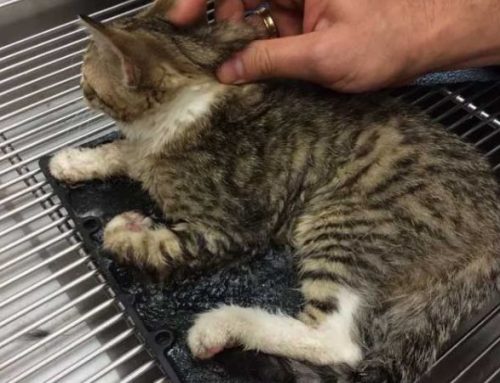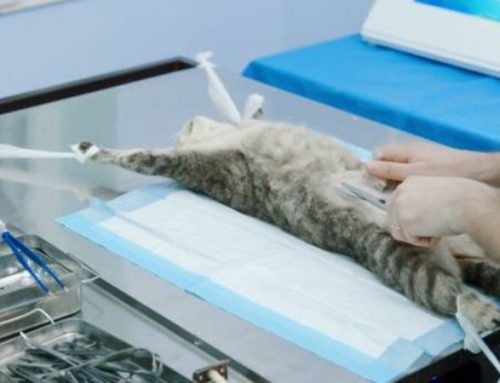When it comes to caring for orphaned newborn kittens, warmth isn’t just comfort it’s a lifeline. Without their mother’s natural heat, these tiny furballs rely on us to create a cozy, safe haven where they can thrive. Join Nexus-Pets as we dive into the essential steps for nurturing these fragile little souls and giving them the best start in life, even when mom isn’t around.
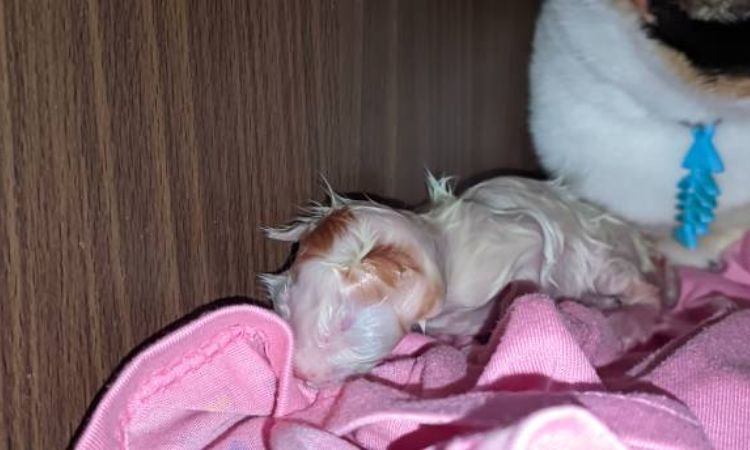
Providing Warmth
1. Importance of External Heat Source
- Newborn kittens are unable to regulate their own body temperature until around 3–4 weeks of age.
- Without external warmth, they are highly susceptible to hypothermia, which can quickly become life-threatening.
- A constant, controlled heat source is critical for their survival, especially in the first few weeks.
2. Recommended Heat Sources
- Use a heating pad (on the lowest setting) placed under one half of the nesting box, never in direct contact with the kitten.
- Heating disks or warm water bottles wrapped in towels can also be used.
- Infrared heat lamps may be suitable for some setups but should be used cautiously to avoid overheating.
3. Temperature Guidelines
- Maintain the ambient temperature around:
- 85°F to 90°F (29°C to 32°C) during the first week.
- Gradually reduce to 80°F (27°C) by the second and third weeks.
- Decrease to 75°F (24°C) by the fourth to fifth week as the kitten begins regulating its own body heat.
- Use a room thermometer or digital pet-safe thermometer to monitor temperatures accurately.
4. Creating a Comfortable Nest
- Line a box or small crate with soft blankets or towels, ensuring they are dry and clean.
- The nest should be enclosed or partially covered to retain warmth and offer a sense of security.
- Position the heat source beneath one side of the bedding to allow a temperature gradient, so the kitten can move away from the warmth if it becomes too hot.
5. Duration of Heating Support
- Continue using a heat source consistently until the kitten is at least 4 weeks old, or until it shows signs of stable self-regulation.
- Some kittens may need warmth until 6 weeks of age, especially if they are underweight, sick, or premature.
- Always ensure kittens are dry before placing near a heat source, as wet fur can increase heat loss and risk burns.
6. Monitoring and Safety
- Check the heat source regularly for safe functioning—avoid overheating or electrical issues.
- Ensure the kitten is not overheating: signs include restlessness, panting, or moving away from the heat.
- Never place kittens directly on the heating pad without a thick towel barrier to avoid skin burns.
Feeding the Kitten
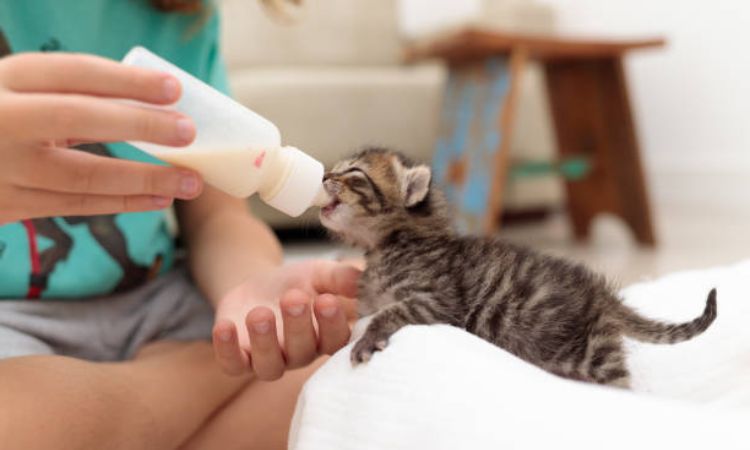
Choosing the Right Nutrition
- Use only a kitten milk replacer (e.g., KMR or similar products available at pet stores or vet clinics).
- Avoid cow’s milk, goat’s milk, or plant-based alternatives — these can cause diarrhea and malnourishment.
- Formula temperature should be body-warm (around 98–100°F or 37°C) before feeding.
Feeding Schedule and Frequency
- Newborns (0–1 week old): Feed every 2 hours, including throughout the night.
- 1–2 weeks old: Feed every 2–3 hours.
- 2–3 weeks old: Feed every 3–4 hours.
- 3–4 weeks old: Feed every 4–5 hours.
- Gradually extend intervals as the kitten grows and begins transitioning to soft food around 4 weeks.
- Feedings must continue overnight for kittens under 3–4 weeks old.
Proper Feeding Technique
- Always feed the kitten on its stomach or side, mimicking a natural nursing position.
- Never feed a kitten on its back — this can cause aspiration (milk entering the lungs), which may be fatal.
- Hold the bottle at a 45-degree angle and allow the kitten to suckle naturally.
- Use nipples made for kittens; adjust hole size carefully so formula drips slowly when inverted.
Monitoring Intake and Health
- Track weight daily using a digital scale accurate to grams.
- Healthy kittens should gain approximately 10–15 grams per day, or 100 grams per week.
- Observe for signs of underfeeding:
- Persistent crying
- Lethargy
- Poor weight gain
- Watch for signs of overfeeding or intolerance:
- Bloating
- Diarrhea
- Vomiting
Hygiene and Equipment Care
- Sterilize bottles, nipples, and any feeding tools after every use with hot water and mild, unscented soap.
- Discard leftover formula after each feeding.
- Keep formula refrigerated and follow expiry guidelines once opened.
Elimination After Feeding
- Kittens under 3 weeks cannot urinate or defecate on their own.
- After each feeding, stimulate the kitten’s genital area with a warm, damp cotton ball or cloth to help eliminate waste.
Veterinary Support and Guidance
- Consult a vet early to:
- Confirm appropriate formula brand
- Establish a customized feeding schedule based on kitten’s size, breed, and condition
- Rule out congenital issues or infections
- Ask your vet if you’re unsure about how much formula to feed or whether your kitten is thriving.
Stimulating Elimination
Newborn kittens need help to urinate and defecate, as they cannot do so on their own. Normally, a mother cat licks her kittens to trigger elimination. For orphaned kittens, use a warm, damp cloth or paper towel to gently rub the lower abdomen and genital area after each feeding.
Hold the kitten on its stomach and apply light circular motions until it urinates or passes stool. This usually takes under a minute. Monitor waste output for normal color and consistency, and contact a vet if there are signs of diarrhea, constipation, or no elimination within 24 hours. Most kittens begin eliminating on their own around 3–4 weeks old.
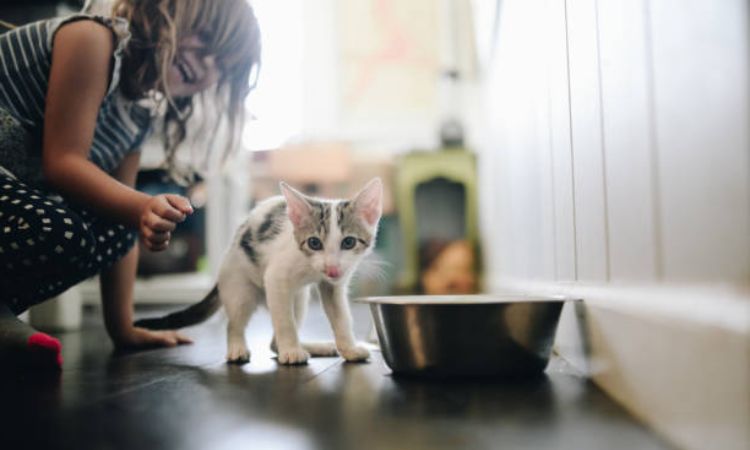
Hygiene and Cleaning
Maintaining proper hygiene is important for the health of young kittens, but full baths should be avoided unless absolutely necessary because they can cause chilling and stress. Instead, spot cleaning with a damp cloth or unscented wipes is recommended if the kitten becomes dirty. After any cleaning, it is crucial to dry the kitten thoroughly to prevent hypothermia or discomfort.
- Avoid giving full baths unless it is essential.
- Use a damp cloth or unscented baby wipes for spot cleaning.
- Always dry the kitten completely after cleaning.
- Prevent chilling by ensuring the kitten stays warm post-cleaning.
Creating a Safe and Comfortable Environment
- Select a quiet, draft-free area that is protected from sudden temperature changes.
- Ensure the space is clean and sanitized regularly to reduce risk of infection.
- Provide soft, warm bedding such as fleece blankets or towels for comfort.
- Keep the kittens separated from other pets and potential hazards (sharp objects, toxic plants, electrical cords).
- Arrange the environment to allow easy access for feeding, cleaning, and monitoring.
Monitoring Health
- Observe kittens daily for any signs of illness, including lethargy, diarrhea, vomiting, coughing, sneezing, or labored breathing.
- Track each kitten’s weight, feeding schedule, and behavior to identify any concerning changes.
- Maintain detailed records to share with a veterinarian.
- Schedule routine veterinary visits for vaccinations, deworming, and overall health assessments.
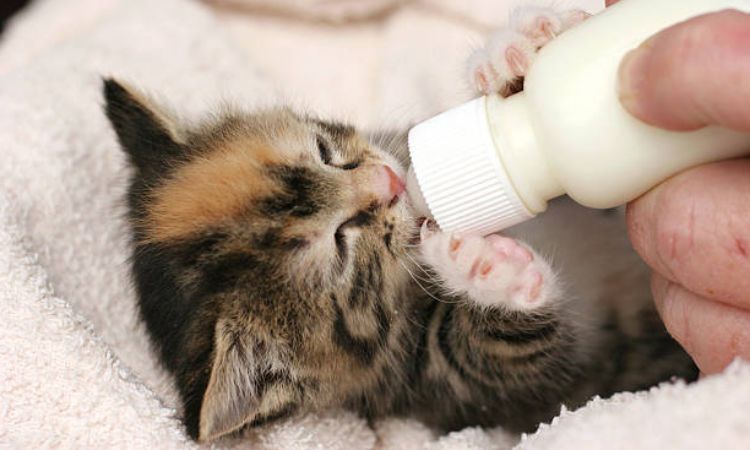
Transition to Solid Food
- Begin introducing softened or moistened kitten food at approximately 3 to 4 weeks of age, while continuing to provide formula.
- Gradually decrease formula feedings as the kitten becomes accustomed to solid food.
- Monitor acceptance of solid food and adjust feeding amounts accordingly.
- Consult with a veterinarian to ensure proper nutrition during this transitional period.
Socialization and Care Beyond the Newborn Stage
- Initiate gentle, consistent handling to foster positive human interaction and reduce fearfulness.
- Provide age-appropriate toys and safe objects to encourage curiosity and play.
- Allow supervised exploration within the safe environment to build confidence and physical skills.
- Continue monitoring the kitten’s growth, behavior, and health status regularly.
- Adapt care routines as the kitten grows, preparing for eventual adoption or integration into a home.
Caring for a motherless newborn kitten is an immense, yet incredibly rewarding, undertaking. While challenging, providing diligent warmth, precise nutrition through bottle-feeding, and meticulous hygiene are paramount for their fragile survival. This round-the-clock commitment, encompassing everything from stimulating elimination to monitoring for the slightest sign of distress, ultimately offers these vulnerable furballs a fighting chance at a healthy, fulfilling life, transforming a desperate situation into a testament of dedicated nurture and unwavering care.





